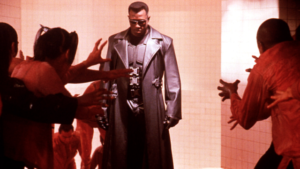Publication Date: 07-14-2021
Blade review (1998)
Dir. Stephen Norrington
By: Steve Pulaski
Rating: ★★★½
It’s almost unfathomable to think had Stephen Norrington’s Blade not been such a financial success upon release in 1998, Marvel Studios as the cinematic titan we know today might not exist. It wasn’t X-Men who got the powerhouse studio up and running. Nor was it a film detailing the origins story of Hulk, Captain America, or Spider-Man. It all came down to a comparatively lesser-known half-man/half-vampire anti-hero who slays the undead with acrobatics and enviable swordsmanship.
Blade‘s release followed comparably darker pictures such as The Crow and Spawn that infused a comic-book visual style into action filmmaking. Prior to its release, superhero movies were not tentpoles but sources of mockery and disappointment. One too many Howard the Ducks and Steels polluted what was a potential-laden ground for visionary filmmaking and interconnected storylines. Not only was Blade a gamble, but it was a darker picture attempting to find a broader audience with its horror-influence, bloodshed, and involving narrative. Next time you praise Marvel, find a breath in the middle of your spiel and use it to put some respect on Blade’s name.
Working off a character who made his debut in the comic Tomb of Dracula #10 back in 1973, the film opens with a quick prologue where we see his human mother give birth to him the night she was bitten by a vampire. Born Eric Brooks, “Blade” (not just played but embodied by Wesley Snipes) entered this world a hybrid, with the physical capabilities of a vampire yet few of the weaknesses (garlic and sunshine don’t seem to phase him whatsoever). While his mother died giving birth, Blade has been raised and mentored by Whistler (Kris Kristofferson of all people), who kindly injects him with a special serum that keeps his humanity in tact, although he might be building a tolerance to it.
It’s Blade who now lives to wage war against vampires, infiltrating raves and night-clubs where they’re privy to bathing in blood and feasting on any unlucky human who comes through the door. Early in the film, he rescues a hematologist named Karen (N’Bushe Wright) after she’s bit by a vampire. Her blood could hold the secret to a new serum possibly curated by Whistler. But Blade’s larger problem comes in the form of Deacon Frost (Stephen Dorff), a young, resourceful vampire keen on ridding the world of the human race.
Reiterating the plot in writing leads me to observe one key detail: how Blade effectively tags the bases for a franchise-starter. We have the origins story of our hero — not painstakingly fleshed out over the entire two hours, blessed so — a trio of characters that are easy enough for whom to root, a compelling villain given life by a menacing Dorff, and we have intrigue lurking on the sidelines in the impossibility of vampires and humans coexisting. Despite all of this, I still had one lingering question: what happens if the vampires successfully eradicate the human race? What is the next food source?
Snipes clearly loves the agility and stoicism offered in his role. He is a towering presence in his bulletproof black trenchcoat and dark shades that allow mystique to serve as his character development. Wright is close to becoming a damsel at the expense of the script, but overtime, Karen is permitted a larger, more active role in her own fate as she adjusts to this unexpected shift in her life that has her on the defense. Kristofferson amusingly provides narrative context and comic relief, and once again, Dorff is about as committed to his role as Snipes. When Blade and Deacon come face-to-face in a handful of scenes, some of the film’s best moments occur.
Cinematographer Theo van de Sande and special-effects-artist-turned-director Stephen Norrington work together to give the film the amalgamated visual style of both a noir and a gritty graphic novel. Blacks and reds dominate the color palette yet are given some sense of diversity by way of numerous locales (bunkers, factories, night-clubs, etc). David S. Goyer’s script constantly has the characters moving, maintaining a level of urgency that doesn’t approach mania but doesn’t allow for stagnation either. Even the fight choreography is pretty immaculate considering there was no blueprint such as The Matrix at the time.
Blade is as complete a superhero film as I’ve seen and its legacy not only laid the groundwork for superhero movies, but darker, more experimental films of the genre.
Starring: Wesley Snipes, N’Bushe Wright, Kris Kristofferson, Stephen Dorff, Udo Kier, and Tracy Lords. Directed by: Stephen Norrington.
About Steve Pulaski
Steve Pulaski has been reviewing movies since 2009 for a barrage of different outlets. He graduated North Central College in 2018 and currently works as an on-air radio personality. He also hosts a weekly movie podcast called "Sleepless with Steve," dedicated to film and the film industry, on his YouTube channel. In addition to writing, he's a die-hard Chicago Bears fan and has two cats, appropriately named Siskel and Ebert!


